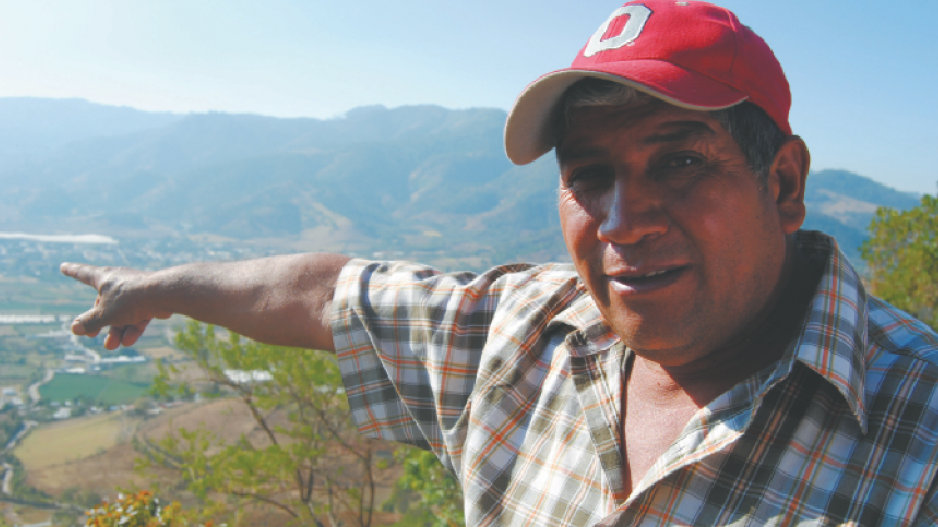Tahoe Resources’ (TSX:THO) Escobal mine in the southern Guatemalan department of Santa Rosa is the world’s third-largest silver mine. It’s only been in commercial operation since 2014, and this year the company’s target is to produce 20 million ounces of silver.
But the mine has had a conflict-riddled start.
The department of Santa Rosa is more well off than the department of San Marcos, where Goldcorp Inc.’s (TSX:G) Marlin mine is located. Santa Rosa is farther south, and most of the country’s indigenous population lives in the north. But the area is still largely agricultural, with many living off what their crops yield.
Artemio Castillo Herrera is a 50-year-old farmer from San Rafael Las Flores.
In April 2013, Castillo and his son were among 20 protesters who left their encampment and marched toward the entrance of the Escobal mine. They were close by around 7 p.m., just as the sky was starting to get dark, when they say they were shot at by the private security personnel contracted to protect the Escobal mining project, which is owned by U.S.- and Canada-based Tahoe Resources through its Guatemalan subsidiary Minera San Rafael.
In a public statement at the time, the company’s CEO, Kevin McArthur, said the protesters were armed with machetes and that the security force responded to what became a hostile situation with tear gas and rubber bullets.
“Our investigation has shown that only non-lethal measures were taken by our security,” he said in a release issued by Tahoe.
Castillo has a different story. He says he took two 9-mm bullets in his leg and 12 shotgun pellets in his back.
Castillo and six other men have filed a lawsuit with the BC Supreme Court against Tahoe Resources. Tahoe has filed a notice of application in response to the Vancouver lawsuit claiming that the BC Supreme Court does not have jurisdiction to hear the case.
A separate criminal case is underway in Guatemala against the mine’s former head of security, Alberto Rotondo. The contractor has been charged with obstruction of justice and causing serious and minor injuries.
All parties agree that there has been a history of violence around the mine. Ira Gostin, Tahoe Resources’ vice-president of investor relations, said the company had reached out to the Guatemalan government for security assistance over concerns of “thugs that roamed the streets” and a “door-to-door campaign of fear” that resulted in an attack on people employed by the mine. Two security guards have lost their lives.
Andrés Dávila, Minera San Rafael’s director of communications, said it’s been a huge challenge handling communications for a mine in a country with zero mining culture.
He’s adamant that many of the surrounding communities now support the mine. But the misinformation, rumours and complaints that plagued the project even before operations began caused challenges.
“It’s not the same in the pictures or in the movies where you can have the image of miners going in the little cart, like the Seven Dwarfs, you know? Well, it’s not like that here. It helps us to get the message across that mining has changed a lot and it has improved drastically over the years.”
Minera San Rafael has worked hard on education, not only within San Rafael Las Flores, but also in eight other municipalities within the mine’s indirect zone of influence. The company said it’s had great success. According to the mine’s development manager Javier Fortín, community engagement events have allowed the company to connect with roughly 35,000 people. In 2014, more than 1,100 San Rafael residents visited the mine, and last year, the company took several mayors from the surrounding municipalities to visit a 500-year-old silver mine in Mexico.
“That was a game-changer as far as persuading or engaging with mayors in the region,” said Fortín. “It’s a process, after all. Building trust and building partnerships take a long time.”
The company has launched countless community programs and initiatives aimed at helping the local population and educating them about not only the work of the mine, but the ability of the mining company to be a catalyst for local development.
The company’s coffee rust program, for example, has supported more than 2,000 local farmers in their battle against coffee rust disease, which Fortín said has affected up to 70% of coffee crops in the country.
The company has also established a vocational training centre, which provides locals the opportunity to upgrade their skills, be it in English, welding, silversmithing or sewing. Thirteen graduates from the program now collectively have a contract to repair the mine’s ventilation sleeves.
Gostin first visited San Rafael Las Flores half a decade ago in February 2010.
“It looked like a Hollywood set to me; there was nobody on, there were no kids around, there was nobody walking on the street, there were no restaurants, there were no banks,” he said.
“When I go down there now, I go to lunch in town, and I walk the street and I say hi to the lady with the shaved ice at the church, who, she teases me because my Spanish is so bad. And I’m really proud of the work that we do.”
But some just want a return to the way life was before the mine’s development. Castillo said the company’s programs have divided communities, neighbourhoods and families between those who participate – and explicitly or implicitly accept the mine – and those who refuse the handouts.
He added that the local economy is suffering because there are rumours that crops produced near the mine are contaminated. Coupled with his injuries, and those of his son who was with him that night in April, it’s affected their welfare.
“It is sad,” he said. “We just want things to return to how they were before.” •




